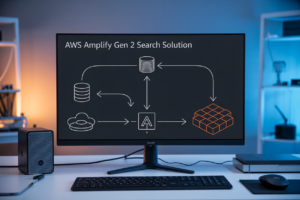Machine learning teams waste countless hours on experiment setup, resource management, and tracking results across scattered tools. Data scientists, ML engineers, and DevOps professionals working with AWS need a streamlined approach to run SageMaker machine learning experiments that actually moves projects forward instead of creating bottlenecks.
Amazon SageMaker transforms the chaotic world of ML model development workflow into an organized, efficient process. Teams can focus on building better models rather than wrestling with infrastructure headaches and manual tracking systems.
This guide shows you how SageMaker’s ML experiment management platform delivers real results. We’ll explore how its core experimentation features eliminate the usual setup friction that slows down projects. You’ll also discover how intelligent resource management drives SageMaker cost optimization while automated model training AWS capabilities speed up your iteration cycles. Finally, we’ll cover how built-in collaboration tools solve the reproducibility nightmare that haunts most ML teams.
Understanding SageMaker’s Core ML Experimentation Features
Managed Jupyter notebooks for seamless development
Amazon SageMaker provides fully managed Jupyter notebooks that eliminate infrastructure headaches. You can spin up notebook instances in minutes, choose from various machine learning frameworks, and access pre-configured environments. These notebooks automatically save your work and scale compute resources as needed. The managed approach means no server maintenance, automatic backups, and seamless integration with other AWS services. Data scientists can focus entirely on experimentation rather than wrestling with environment setup.
Built-in algorithms and framework support
SageMaker offers battle-tested built-in algorithms for common machine learning tasks like classification, regression, clustering, and recommendation systems. These algorithms are optimized for cloud-scale performance and handle data preprocessing automatically. The platform also supports popular frameworks including TensorFlow, PyTorch, scikit-learn, and XGBoost. You can bring your own custom algorithms using Docker containers, giving you flexibility while maintaining the benefits of managed infrastructure. This comprehensive ML model development workflow accelerates project timelines significantly.
Automated model tuning and hyperparameter optimization
Hyperparameter tuning transforms from tedious manual work into an automated process with SageMaker’s intelligent optimization engine. The service uses Bayesian optimization to efficiently explore hyperparameter combinations and find optimal settings. You define parameter ranges and optimization objectives, then SageMaker runs multiple training jobs simultaneously to discover the best configuration. This SageMaker machine learning experiments feature can improve model performance by 10-15% while reducing tuning time from weeks to hours. Smart early stopping prevents wasteful training on underperforming configurations.
Integrated data preprocessing and feature engineering tools
Data preparation becomes streamlined through SageMaker Processing and Data Wrangler. These tools handle common preprocessing tasks like data cleaning, transformation, and feature engineering at scale. Data Wrangler provides a visual interface for exploring datasets and creating preprocessing workflows without writing code. Processing jobs can run feature engineering pipelines on massive datasets using distributed computing. The platform integrates with AWS Glue for complex ETL operations and supports real-time feature stores for consistent data access across training and inference workloads.
Streamlining Model Development and Training Processes
One-click Training Job Deployment
Amazon SageMaker transforms ML model development workflow by eliminating complex infrastructure setup. Data scientists can launch training jobs instantly through the console or SDK, automatically provisioning compute resources and managing dependencies. This streamlined approach removes traditional barriers, letting teams focus on model architecture rather than infrastructure management.
Distributed Training Capabilities for Large Datasets
SageMaker’s distributed training infrastructure handles massive datasets across multiple instances seamlessly. The platform automatically splits data and coordinates training across nodes, dramatically reducing training time for complex models. Built-in algorithms support both data and model parallelism, enabling efficient processing of terabyte-scale datasets that would be impossible on single machines.
Real-time Monitoring and Logging of Training Metrics
Training visibility becomes effortless with SageMaker’s comprehensive monitoring dashboard. Real-time metrics tracking shows loss curves, accuracy trends, and resource utilization as jobs progress. CloudWatch integration captures detailed logs and custom metrics, while automatic alerts notify teams of training anomalies or completion status, ensuring experiments stay on track without constant manual oversight.
Accelerating Experiment Iteration and Testing Cycles
Parallel experiment execution across multiple instances
SageMaker’s distributed training capabilities allow data scientists to run multiple ML experiments simultaneously across different compute instances. This parallel processing dramatically reduces the time needed to test various hyperparameters, model architectures, and training configurations. Teams can launch dozens of experiments at once, with each instance handling different parameter combinations while automatically scaling resources based on workload demands.
Automated A/B testing framework for model comparison
The platform includes built-in A/B testing tools that automatically compare model performance across different variants. SageMaker tracks key metrics like accuracy, precision, and recall for each model version, providing statistical significance tests to determine the winning approach. This automated comparison eliminates manual testing overhead and ensures objective model selection based on real performance data rather than intuition.
Version control and experiment tracking capabilities
Every ML experiment tracking session in SageMaker gets automatically logged with complete metadata, including code versions, dataset snapshots, and hyperparameter settings. The experiment management platform maintains a detailed history of all training runs, making it easy to reproduce successful experiments or identify what changes led to performance improvements. This comprehensive tracking system prevents the common problem of losing track of promising experimental configurations.
Rapid prototyping with pre-built model templates
SageMaker provides ready-to-use templates for common machine learning tasks like image classification, natural language processing, and time series forecasting. These pre-configured environments include optimized algorithms, appropriate instance types, and proven training scripts that can be customized quickly. Data scientists can launch new experiments within minutes rather than spending hours setting up infrastructure and debugging configuration issues.
Cost Optimization Through Intelligent Resource Management
Automatic scaling based on workload demands
SageMaker automatically adjusts compute resources based on your ML experiment needs, scaling up during intensive training phases and down during idle periods. This intelligent scaling prevents over-provisioning while ensuring optimal performance for SageMaker machine learning experiments.
Spot instance integration for budget-friendly training
SageMaker cost optimization shines through spot instance integration, offering up to 90% savings on compute costs. The platform handles spot instance interruptions gracefully, automatically resuming training when instances become available again, making efficient machine learning training accessible even with tight budgets.
Pay-per-use pricing model eliminates infrastructure overhead
The pay-per-use model transforms how teams approach ML model development workflow economics. You only pay for actual compute time used during training and inference, eliminating the need to maintain expensive infrastructure. This approach makes Amazon SageMaker advantages particularly compelling for organizations running sporadic experiments or those scaling their machine learning initiatives without massive upfront investments.
Enhanced Collaboration and Reproducibility Benefits
Shared workspaces for team-based ML projects
SageMaker Studio provides collaborative workspaces where multiple data scientists can work together on machine learning projects. Team members can share notebooks, datasets, and experiments in real-time, making it easy to hand off work between colleagues. The platform tracks who made what changes and when, so everyone stays on the same page. You can set permissions to control who can access specific resources, keeping sensitive data secure while promoting collaboration.
Standardized experiment documentation and reporting
Every experiment in SageMaker gets automatically documented with detailed metadata, parameters, and results. The platform creates consistent reports that capture model performance metrics, training configurations, and data lineage without manual effort. This standardized approach means anyone on your team can quickly understand what was tried before and why certain decisions were made. The automatic documentation saves hours of manual record-keeping and ensures nothing important gets lost.
Easy model sharing and deployment across environments
Moving models between development, testing, and production environments becomes seamless with SageMaker’s model registry. You can package models with their dependencies and deploy them across different AWS accounts or regions with just a few clicks. The platform handles version control and maintains compatibility, so models behave consistently regardless of where they’re running. This eliminates the “it works on my machine” problem that often plagues ML teams.
Consistent development environments reduce setup time
SageMaker provides pre-configured environments with popular ML frameworks and libraries already installed. New team members can start working immediately without spending days setting up their development environment. Everyone uses the same versions of libraries and tools, which eliminates compatibility issues and ensures reproducible results. The managed environments automatically update with security patches and new features, keeping everything current without manual intervention.
Automated backup and recovery of experiment data
The platform automatically backs up your experiments, notebooks, and model artifacts to secure cloud storage. If something goes wrong, you can restore previous versions of your work without losing progress. SageMaker maintains a complete history of changes, so you can roll back to any point in time. This automatic backup system gives you peace of mind and protects against data loss from accidental deletions or system failures.
Running machine learning experiments doesn’t have to be a constant battle with infrastructure headaches and resource management nightmares. SageMaker transforms the entire ML experimentation process by providing powerful built-in features that streamline model development, speed up training cycles, and automatically optimize costs. The platform’s intelligent resource management means you can focus on what really matters – building better models – while it handles the heavy lifting of scaling and resource allocation behind the scenes.
The real game-changer lies in how SageMaker brings teams together and makes experiments truly reproducible. No more “it worked on my machine” conversations or lost experiment configurations. If you’re tired of wrestling with ML infrastructure and want to run experiments that are both efficient and collaborative, give SageMaker’s experimentation features a try. Your future self (and your team) will thank you for making the switch to a platform that actually gets how modern ML teams want to work.




















